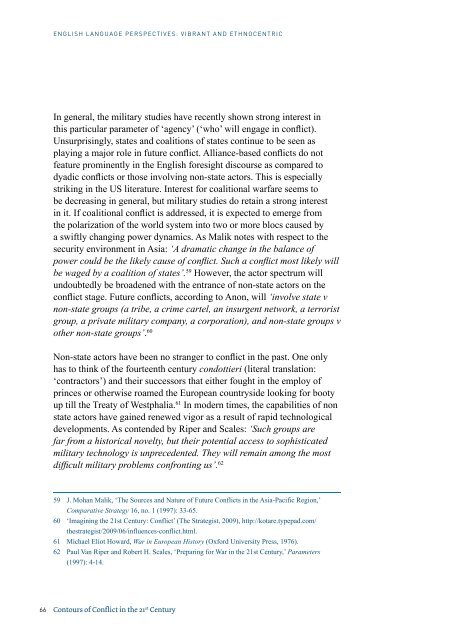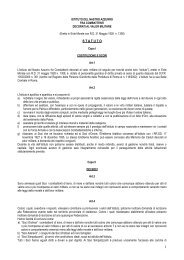Contours of Conflict in the 21st Century
Contours of Conflict in the 21st Century
Contours of Conflict in the 21st Century
- No tags were found...
You also want an ePaper? Increase the reach of your titles
YUMPU automatically turns print PDFs into web optimized ePapers that Google loves.
ENGLISH LANGUAGE PERSPECTIVES: VIBRANT AND ETHNOCENTRICIn general, <strong>the</strong> military studies have recently shown strong <strong>in</strong>terest <strong>in</strong>this particular parameter <strong>of</strong> ‘agency’ (‘who’ will engage <strong>in</strong> conflict).Unsurpris<strong>in</strong>gly, states and coalitions <strong>of</strong> states cont<strong>in</strong>ue to be seen asplay<strong>in</strong>g a major role <strong>in</strong> future conflict. Alliance-based conflicts do notfeature prom<strong>in</strong>ently <strong>in</strong> <strong>the</strong> English foresight discourse as compared todyadic conflicts or those <strong>in</strong>volv<strong>in</strong>g non-state actors. This is especiallystrik<strong>in</strong>g <strong>in</strong> <strong>the</strong> US literature. Interest for coalitional warfare seems tobe decreas<strong>in</strong>g <strong>in</strong> general, but military studies do reta<strong>in</strong> a strong <strong>in</strong>terest<strong>in</strong> it. If coalitional conflict is addressed, it is expected to emerge from<strong>the</strong> polarization <strong>of</strong> <strong>the</strong> world system <strong>in</strong>to two or more blocs caused bya swiftly chang<strong>in</strong>g power dynamics. As Malik notes with respect to <strong>the</strong>security environment <strong>in</strong> Asia: ‘A dramatic change <strong>in</strong> <strong>the</strong> balance <strong>of</strong>power could be <strong>the</strong> likely cause <strong>of</strong> conflict. Such a conflict most likely willbe waged by a coalition <strong>of</strong> states’. 59 However, <strong>the</strong> actor spectrum willundoubtedly be broadened with <strong>the</strong> entrance <strong>of</strong> non-state actors on <strong>the</strong>conflict stage. Future conflicts, accord<strong>in</strong>g to Anon, will ‘<strong>in</strong>volve state vnon-state groups (a tribe, a crime cartel, an <strong>in</strong>surgent network, a terroristgroup, a private military company, a corporation), and non-state groups vo<strong>the</strong>r non-state groups’. 60Non-state actors have been no stranger to conflict <strong>in</strong> <strong>the</strong> past. One onlyhas to th<strong>in</strong>k <strong>of</strong> <strong>the</strong> fourteenth century condottieri (literal translation:‘contractors’) and <strong>the</strong>ir successors that ei<strong>the</strong>r fought <strong>in</strong> <strong>the</strong> employ <strong>of</strong>pr<strong>in</strong>ces or o<strong>the</strong>rwise roamed <strong>the</strong> European countryside look<strong>in</strong>g for bootyup till <strong>the</strong> Treaty <strong>of</strong> Westphalia. 61 In modern times, <strong>the</strong> capabilities <strong>of</strong> nonstate actors have ga<strong>in</strong>ed renewed vigor as a result <strong>of</strong> rapid technologicaldevelopments. As contended by Riper and Scales: ‘Such groups arefar from a historical novelty, but <strong>the</strong>ir potential access to sophisticatedmilitary technology is unprecedented. They will rema<strong>in</strong> among <strong>the</strong> mostdifficult military problems confront<strong>in</strong>g us’. 6259 J. Mohan Malik, ‘The Sources and Nature <strong>of</strong> Future <strong>Conflict</strong>s <strong>in</strong> <strong>the</strong> Asia-Pacific Region,’Comparative Strategy 16, no. 1 (1997): 33-65.60 ‘Imag<strong>in</strong><strong>in</strong>g <strong>the</strong> <strong>21st</strong> <strong>Century</strong>: <strong>Conflict</strong>’ (The Strategist, 2009), http://kotare.typepad.com/<strong>the</strong>strategist/2009/06/<strong>in</strong>fluences-conflict.html.61 Michael Eliot Howard, War <strong>in</strong> European History (Oxford University Press, 1976).62 Paul Van Riper and Robert H. Scales, ‘Prepar<strong>in</strong>g for War <strong>in</strong> <strong>the</strong> <strong>21st</strong> <strong>Century</strong>,’ Parameters(1997): 4-14.66<strong>Contours</strong> <strong>of</strong> <strong>Conflict</strong> <strong>in</strong> <strong>the</strong> 21 st <strong>Century</strong>










